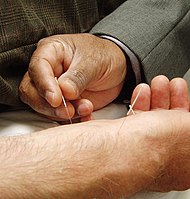
Photo from wikipedia
Abstract Objectives: To explore informal and unsanctioned techniques general practitioners (GPs) employ as a means to increase the likelihood of sickness certificate approval, following the Swedish Social Insurance Agency’s (SSIA’s)… Click to show full abstract
Abstract Objectives: To explore informal and unsanctioned techniques general practitioners (GPs) employ as a means to increase the likelihood of sickness certificate approval, following the Swedish Social Insurance Agency’s (SSIA’s) consolidation of the gatekeeping role in sickness benefit evaluation. Design: Qualitative semi-structured interviews with 20 GPs working in Swedish primary care. A thematic analysis of the transcribed material was carried out to map different techniques employed by the practitioners. Results: Eight techniques were identified, particularly with respect to the way in which the sickness certificate is written to ensure approval by the SSIA. The identified techniques were most commonly adopted when the patient’s case was perceived to be at high risk for rejection by the SSIA (such as psychiatric illnesses, chronic pain etc.). Conclusions: The findings imply that the informal and unsanctioned techniques are complex and ambiguous. They are used intentionally and covertly. The study also suggests that, while the consolidation of SSIA’s gatekeeping role may have resolved some sickness absence issues, a consequence may be that GPs develop unsanctioned techniques to ensure compliance.
Journal Title: Scandinavian Journal of Primary Health Care
Year Published: 2019
Link to full text (if available)
Share on Social Media: Sign Up to like & get
recommendations!